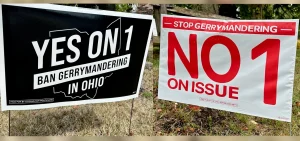News
Some Ohioans say voters will be tricked by ballot language for redistricting issue
By: Jo Ingles | Statehouse News Bureau
Posted on:
COLUMBUS, Ohio (Statehouse News Bureau) — There’s only one statewide issue on next month’s ballot. And there appears to be some anecdotal evidence that the ballot summary language for Issue 1 is confusing some voters.

Delaware resident Kelly Vogt said when she went to cast her early ballot, she knew she wanted to vote for Issue 1.
“But then when I got there, I started reading the language because I hadn’t read it ahead of time and it’s very confusing. It leads you to believe it’s causing more gerrymandering,” Vogt said.
Vogt voted against the amendment and said she later realized she had cast her ballot to keep the status quo.
Issue 1 would replace the seven elected officials on the Ohio Redistricting Commission – now dominated by Republicans – with a 15-member panel composed equally of Republicans, Democrats, and independents. Current or former politicians, lobbyists, party officials, or others with political connections would be banned from the panel. The panel would use a proportionality formula based on the results of the last six years of statewide elections to draw legislative and congressional maps.
Matt Dole with Ohio Works, the group opposing Issue 1, said the ballot summary isn’t confusing voters.
“If people go in and intend to vote for Issue 1, read the ballot language and vote no, they are not confused,” Dole said. “They are reading the ballot language and realizing what they are hearing out there from the Issue 1 crowd doesn’t match what is on the ballot.”
(Read the ballot summary language here.)
It is true that the ballot language doesn’t match the language in the amendment. The ballot language approved by the Ohio Ballot Board at an August meeting was written by Republican Secretary of State Frank LaRose, who chairs that panel. His wording was changed slightly by fellow board member Sen. Theresa Gavarone (R-Bowling Green). She suggested replacing the word “manipulate” in a line describing the district line-drawing process with the word “gerrymander”. That prompted an outburst from Issue 1’s supporters.
Democrats on the board also protested and took the ballot summary to the Ohio Supreme Court. The Republican majority said the language was ok with a minor technical change. Democrats blasted it, with Justice Jennifer Brunner writing that it is “perhaps the most stunningly stilted ballot language that Ohio voters will have ever seen.”
Issue 1’s backers are telling voters to read the full amendment before voting, because that is what will be enacted if the issue is approved, not the ballot summary wording.
“The important thing for people to understand is the ballot language is false and misleading and it is not the actual amendment itself,” said Chris Davey with the Issue 1 group Citizens Not Politicians.
“When Issue 1 passes, the ballot language will go away and what will remain is the Citizens Not Politicians amendment,” Davey said. “It will ‘ban partisan gerrymandering and prohibit the use of redistricting plans that favor one political party and disfavor others.’ So that’s what people are voting on and if you want to ban gerrymandering, you need to vote yes on Issue 1,” Davey said.
(Read the full amendment here.)
The “yes on 1” signs say Issue 1 would ban gerrymandering. But the “no on 1” signs also say that. Experts note that when voters are confused, they often vote “no” or don’t vote at all. But the issue’s opponents said they’re not counting on confusion to win.
“I don’t think anybody’s counting on all the people are going to just vote ‘no’ because they don’t like it.” said Ryan Stubenrauch, a Republican strategist who speaks for the “no on 1” campaign. “I think people are going to read the summary and say, I don’t think that sounds so good, and I hope they do vote ‘no’.”
But Vogt said she felt like she was tricked out of voting for what she wanted.
“It threw me and at the last minute I voted no and I’m really regretting that now and I feel like that is false advertising,” Vogt said.

